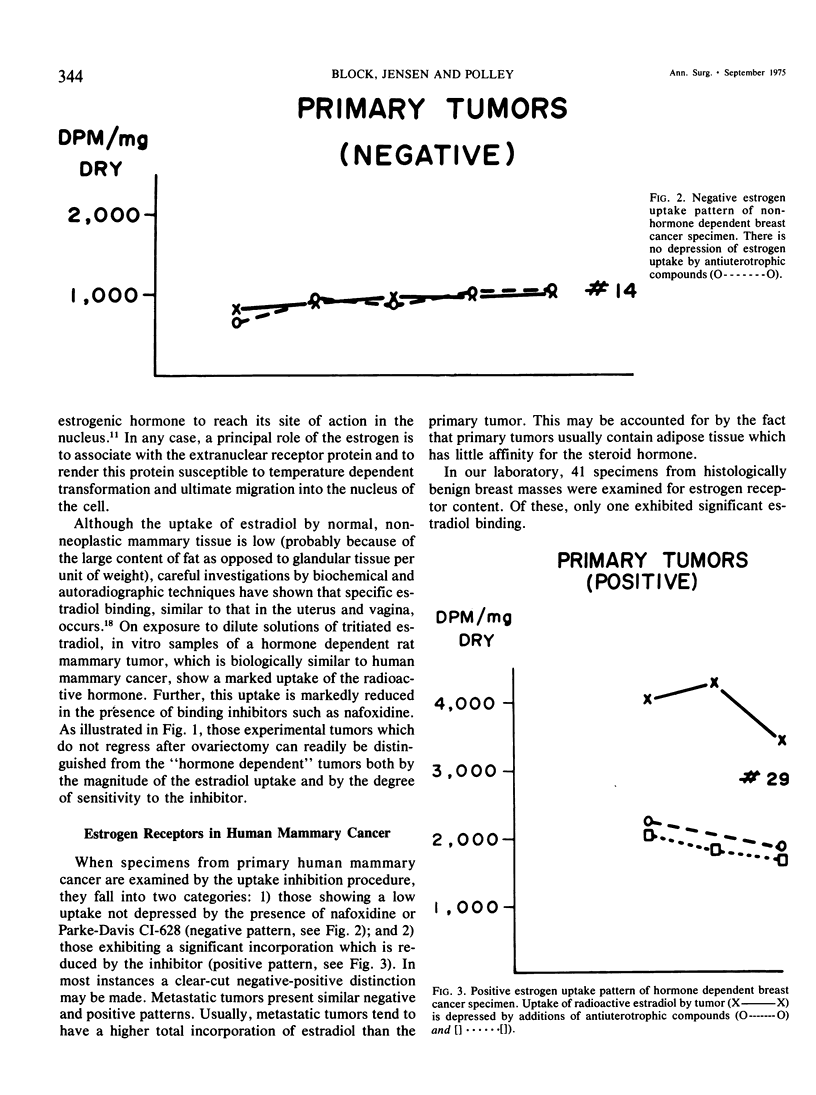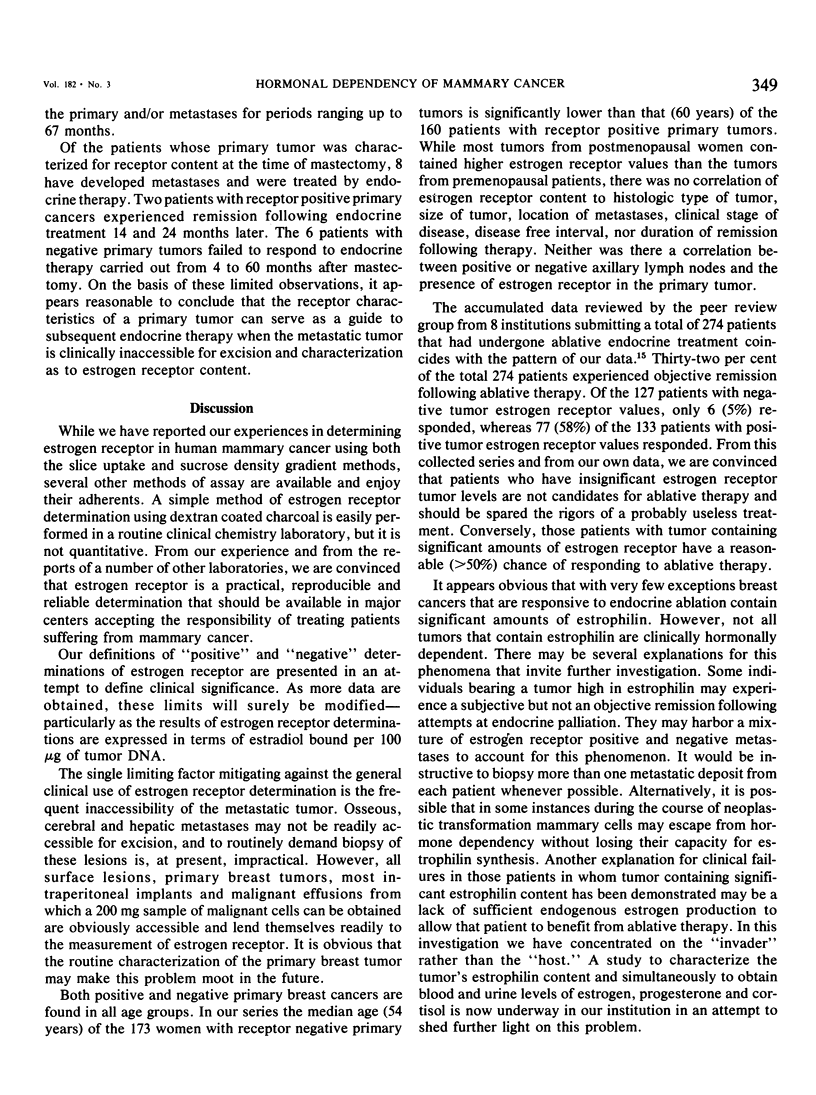Abstract
The estrogen receptor protein (estrophilin) was determined in specimens from 359 primary breast cancers and from metastatic tumors of 214 patients. Ninety-eight patients were eventually treated by some form of endocrine therapy: 82 patients were treated by ablative therapy, and 16 by hormonal additive treatment. The records of 81 of the 98 patients whose tumors were characterized for estrogen receptor content and who had received some type of endocrine therapy were reviewed by a peer review group that assessed the objective data for these patients regarding objective remission or failure to treatment. A positive estrophilin determination was defined as receptor content greater than 250 fmole per gram of tumor for premenopausal females and greater than 750 fmole per gram of tumor for postmenopausal and previously castrated patients. Estrogen receptor determinations may be made from tumor specimens as small as 200 mg. Sixty-nine patients underwent some form of ablative therapy. Twenty-seven of these patients were found to have significant receptor determinations. Of those patients in whom a definite determination was made of their post-treatment response, roughly two-thirds experienced objective remissions. None of the 42 patients with negative estrogen receptor determination experienced an objective remission to ablative endocrine therapy. Only one of 6 patients with negative determinations benefited from additive hormonal therapy; 4 of 6 patients with positive determinations benefited from additive therapy. Not all women with receptor containing mammary cancer will respond favorably to endocrine therapy, but those patients whose tumors lack a critical amount of estrophilin have little chance of benefit from either endocrine ablation or hormone administration. The estrogen receptor content of the primary tumor indicates the hormonal dependency of the tumor and may be used to predict the response to endocrine treatment when recurrent disease appears.
Full text
PDF









Selected References
These references are in PubMed. This may not be the complete list of references from this article.
- Dao T. L., Libby P. R. Conjugation of steroid hormones by breast cancer tissue and selection of patients for adrenalectomy. Surgery. 1969 Jul;66(1):162–166. [PubMed] [Google Scholar]
- FOLCA P. J., GLASCOCK R. F., IRVINE W. T. Studies with tritium-labelled hexoestrol in advanced breast cancer. Comparison of tissue accumulation of hexoestrol with response to bilateral adrenalectomy and oophorectomy. Lancet. 1961 Oct 7;2(7206):796–798. doi: 10.1016/s0140-6736(61)91088-1. [DOI] [PubMed] [Google Scholar]
- GLASCOCK R. F., HOEKSTRA W. G. Selective accumulation of tritium-labelled hexoestrol by the reproductive organs of immature female goats and sheep. Biochem J. 1959 Aug;72:673–682. doi: 10.1042/bj0720673. [DOI] [PMC free article] [PubMed] [Google Scholar]
- HUGGINS C., BERGENSTAL D. M. Inhibition of human mammary and prostatic cancers by adrenalectomy. Cancer Res. 1952 Feb;12(2):134–141. [PubMed] [Google Scholar]
- HUGGINS C., DAO T. L-Y. Characteristics of adrenal-dependent mammary cancers. Ann Surg. 1954 Oct;140(4):497–501. doi: 10.1097/00000658-195410000-00005. [DOI] [PMC free article] [PubMed] [Google Scholar]
- JESSIMAN A. G., MOORE F. D. Carcinoma of the breast; the study and treatment of the patient. N Engl J Med. 1956 May 3;254(18):846–contd. doi: 10.1056/NEJM195605032541808. [DOI] [PubMed] [Google Scholar]
- Jensen E. V., Numata M., Brecher P. I., Desombre E. R. Hormone-receptor interaction as a guide to biochemical mechanism. Biochem Soc Symp. 1971;32:133–159. [PubMed] [Google Scholar]
- Jensen E. V., Suzuki T., Kawashima T., Stumpf W. E., Jungblut P. W., DeSombre E. R. A two-step mechanism for the interaction of estradiol with rat uterus. Proc Natl Acad Sci U S A. 1968 Feb;59(2):632–638. doi: 10.1073/pnas.59.2.632. [DOI] [PMC free article] [PubMed] [Google Scholar]
- Leung B. S., Fletcher W. S., Lindell T. D., Wood D. C., Krippaechne W. W. Predictability of response to endocrine ablation in advanced breast carcinoma. A correlation to estrogen receptor and steroid sulfurylation. Arch Surg. 1973 Apr;106(4):515–519. doi: 10.1001/archsurg.1973.01350160129021. [DOI] [PubMed] [Google Scholar]
- Nissen-Meyer R. The role of prophylactic castration in the therapy of human mammary cancer. Eur J Cancer. 1967 Nov;3(4):395–403. doi: 10.1016/0014-2964(67)90024-2. [DOI] [PubMed] [Google Scholar]
- Shyamala G., Gorski J. Estrogen receptors in the rat uterus. Studies on the interaction of cytosol and nuclear binding sites. J Biol Chem. 1969 Mar 10;244(5):1097–1103. [PubMed] [Google Scholar]


